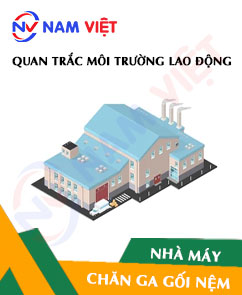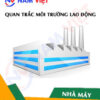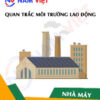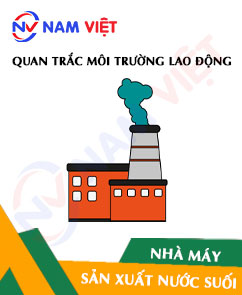Occupational environment monitoring at the bedding and mattress factory
99,000 ₫
Note: The above price is calculated for one sample, the price may vary depending on the area of the environment that needs monitoring and the movement of the market. For more accurate price support, please refer to the quotation table or contact directly with our consulting staff.
Environmental monitoring of a bedding and mattress factory is a session of collecting, analyzing, and evaluating factors in the workplace that may harm workers health.
Table of Contents
Toggle1. Overview of Bedding and Mattress Manufacturing Factories
a. What is a bedding and mattress manufacturing factory?
A manufacturing factory for bedding and mattresses is a facility where processes for producing bed sheets, blankets, pillows, and mattresses are carried out. In this factory, all stages—from material processing, cutting and sewing, packaging, to quality inspection—are performed to produce finished bedding products. The factory uses suitable equipment, machinery, and production procedures to ensure high-quality output that meets market demand.

b. Production stages in a bedding and mattress manufacturing factory
In a bedding and mattress manufacturing factory, the typical production stages include:
- Material preparation: Processing and preparing raw materials such as fabrics, cotton, synthetic fibers, padding materials, and other components needed for bedding and mattresses.
- Cutting and sewing: Cutting fabrics and sewing the parts of bed sheets, blankets, and pillows according to specific sizes and designs. This stage includes cutting fabric into pieces, sewing edges, seams, and other details of bedding products.
- Packing and padding: After sewing, bedding parts are packed and padded with cotton, synthetic fibers, or other padding materials. This may involve placing padding layers between fabric layers and arranging them according to size and shape.
- Finishing and decoration: After padding, the bedding products are finished with accessories such as buttons, zippers, ties, or other decorative details to provide a polished look and aesthetic appeal.
- Quality inspection: Before packaging and shipping, the products undergo quality inspection to ensure they meet standards for size, durability, and usability.
- Packing and shipping: Finally, bedding products are packed according to proper procedures to ensure safety during transport and delivery. They are then shipped for distribution to customers.

c. Machinery used in bedding and mattress manufacturing factories
Bedding and mattress manufacturing factories use various machinery to perform production stages. Common equipment includes:
- Automatic fabric cutting machines: Used to cut fabric into pieces according to specific sizes and shapes for bedding products.
- Industrial sewing machines: Multi-functional machines for sewing bedding parts such as edges, seams, and other details. Different types of sewing machines are used depending on the stage and complexity of the product.
- Automatic packing and padding machines: Machines used to pack and pad bedding products with cotton, synthetic fibers, or other padding materials. They can automatically place padding layers between fabric layers and arrange them as required.
- Automatic button fastening machines: Used to attach buttons on bedding, securing layers of fabric and padding together.
- Heat press and surface processing machines: Used to heat press components like covers, corners, or decorative details. Surface processing machines create patterns, logos, or designs on the bedding surface.
- Quality inspection machines: Used to check dimensions, durability, elasticity, and other quality standards of bedding products.

d. Occupational diseases for workers in bedding and mattress factories
Workers in bedding and mattress factories may encounter some occupational diseases caused by environmental factors, work conditions, and unhealthy practices. Common occupational diseases include:
- Respiratory diseases: Workers may be exposed to dust, chemical vapors, or fumes during material handling, potentially causing asthma, bronchitis, pneumonia, and other respiratory issues.
- Skin diseases: Contact with chemicals, detergents, or other materials during production may cause dermatitis, allergies, eczema, or other skin conditions.
- Musculoskeletal disorders: Jobs involving lifting, pulling, transporting, and assembling can stress bones, muscles, and joints, leading to back pain, arthritis, or other musculoskeletal injuries.
- Accidental injuries: Cuts, punctures, or collisions may occur when working with cutting tools, machines, and other equipment, leading to serious injuries or work accidents.
- Noise-induced issues: Machinery in bedding factories can generate high noise levels, which may cause hearing loss, sleep disturbance, stress, and other negative health effects.
To mitigate these risks, bedding and mattress factories should implement safety measures such as providing personal protective equipment, training workers in occupational safety, ensuring workplace hygiene, controlling noise, and applying risk management practices.

e. Popular types of bedding and mattresses on the market
Various bedding products are widely used in households, hotels, and other accommodations. Common types include:
- Cotton bedding: Made from natural or synthetic cotton, offering softness, breathability, and easy maintenance.
- Rubber bedding: Made from natural or synthetic rubber, providing good elasticity, support, and hypoallergenic properties.
- Foam bedding: Made from foam, with high elasticity and durability, offering comfort and body support.
- Spring bedding: Featuring internal springs for support and elasticity, available in different firmness levels to suit user preference.
- Natural material bedding: Made from materials such as linen, silk, wool, felt, or organic cotton, offering breathability, softness, and eco-friendliness.
- Memory foam bedding: Made from memory foam, which conforms to body shape and temperature, providing comfort and support.
2. Overview of Occupational Environment Monitoring Services
a. What is occupational environment monitoring in bedding factories?
Occupational environment monitoring (or workplace measurement) in bedding and mattress factories involves collecting, evaluating, and analyzing measurements of workplace environmental factors to implement timely measures, minimize environmental harm to workers’ health, and prevent occupational diseases. Monitoring is mandatory for bedding factories.
It is crucial for protecting workers’ health because employees are the primary resource generating profit for the company. Workers regularly exposed to hazardous factors above permissible limits may suffer health impacts and develop occupational diseases.
REGISTER FOR OCCUPATIONAL ENVIRONMENT MONITORING SERVICE
b. An Toan Nam Viet’s occupational environment monitoring program
An Toan Nam Viet’s monitoring program is developed by engineers specializing in occupational safety and environmental protection. The program uses modern measurement methods to monitor air quality, water, microclimate, physical factors, and dust in the workplace. It plays a vital role in ensuring a safe working environment and protecting workers’ health.
Additionally, the program helps research and develop solutions to improve workplace environmental quality. With the professionalism and dedication of monitoring experts, An Toan Nam Viet’s exclusive program represents a breakthrough in occupational safety and environmental management in Vietnam.

c. Standardization in workplace measurement procedures
Standardization in An Toan Nam Viet’s workplace measurement procedures ensures accuracy and reliability. The program follows recognized standards and procedures from the Ho Chi Minh City Department of Health. Data collected are highly reliable for evaluating workplace conditions and making informed decisions to improve safety and protect workers’ health.
These procedures are carried out by highly qualified monitoring specialists, giving managers confidence in the results from An Toan Nam Viet for accurate decision-making.
By applying standardized procedures, An Toan Nam Viet demonstrates its commitment to a safe workplace and worker health while contributing to higher occupational safety and environmental management quality in Vietnam.
d. Monitoring report for bedding factories
Monitoring results are compiled according to Form No. 04, Appendix III of Decree 44/2016/ND-CP in two copies: one sent to the contracting workplace and one retained by the monitoring organization.
Records are kept indefinitely according to the law.

e. Frequency of occupational environment monitoring according to the law
According to Clause 2 of Article 18 of the Law on Occupational Safety and Hygiene 84/2015/QH13, employers must conduct workplace monitoring at least once a year.
f. Deadline for submitting monitoring reports according to the law
Reports must be submitted before December 31 each year to the local Department of Health where the factory is located and where workers are employed. Updates are required when technology, production processes, or facilities change, creating new hazards.
g. Penalties for violations of workplace monitoring regulations for employers
According to Article 27 of Decree 12/2022/ND-CP dated 17/01/2022:
- Clause 2: Fine of 2,000,000 – 5,000,000 VND for failing to publicly inform workers about monitoring results and hazard management.
- Clause 3: Fine of 20,000,000 – 40,000,000 VND for failing to conduct workplace monitoring to control hazards to workers’ health.
- Clause 4: Fine of 40,000,000 – 60,000,000 VND for cooperating with monitoring organizations in fraudulent monitoring activities without reaching criminal liability.
3. Harmful environmental factors for workers in bedding and mattress factories
Workers in bedding and mattress factories may be exposed to several harmful environmental factors that can affect their health. Below are some potential hazards:
- Dust and particles: The production process of bedding and mattresses can generate dust and particles from materials such as cotton, foam, fabric, and fibers. Inhaling these particles can cause respiratory problems and allergies.
- Chemicals: During production, chemicals such as adhesives, coatings, or cleaning agents may be used. Exposure to these substances can cause skin irritation, dermatitis, rhinitis, pneumonia, and other health issues.
- Noise: Machinery and equipment in bedding and mattress factories can produce high levels of noise. Continuous exposure to noise can cause stress, insomnia, hearing loss, and negatively affect overall health.
- Temperature and humidity: The working environment in the factory may have high temperature and humidity due to production processes and machinery. This can lead to fatigue, dehydration, body temperature imbalance, and reduced work performance.
- Toxins from materials: Materials used in bedding and mattress production, such as foam, adhesives, or other chemical substances, may contain harmful toxins such as formaldehyde, toluene, and phenol. Exposure to these substances can cause skin and respiratory damage and affect overall health.
REGISTER FOR OCCUPATIONAL ENVIRONMENT MONITORING SERVICE
4. Measures to improve the working environment in bedding and mattress factories
To improve the working environment in bedding and mattress factories and ensure worker health, the following measures can be applied:
- Ensure ventilation and fan systems: Provide effective ventilation in the factory to ensure air circulation and reduce dust, chemical fumes, and high temperatures. Use fans and air purifiers to remove harmful dust and particles from the air.
- Use personal protective equipment (PPE): Ensure workers are provided with PPE such as masks, gloves, safety goggles, and chemical-resistant clothing. This protects skin, respiratory system, and eyes from harmful substances and dust during work.
- Training and safety education: Provide workers with training and guidance on occupational safety, protective equipment, and safe working practices. Ensure all employees have the knowledge and awareness to protect their health and safety.
- Toxic material control: Ensure production processes and material usage are safe and non-harmful to health. If necessary, implement control measures such as vacuum extraction, exhaust fans, and ensure coatings or cleaning chemicals are safely used.
- Noise management: Implement measures to reduce noise at the source, such as using soundproof panels, installing sound insulation, and providing ear protection to workers when needed. Ensure noise levels do not exceed safety limits.
- Work environment assessment and monitoring: Regularly evaluate and monitor the working environment to identify potential issues and take corrective actions promptly. Check air quality, temperature, humidity, and other environmental factors to ensure compliance with safety standards.
- Encourage safe work practices: Create a safe working environment by encouraging workers to follow safe procedures, adhere to equipment and machinery usage rules, and report safety issues immediately.
- Regularly conduct occupational environment monitoring in factories, collect and analyze harmful factors affecting workers, and adjust measures to reduce risks to prevent occupational diseases.
5. Benefits of periodic monitoring in bedding and mattress factories
An Toan Nam Viet provides enterprises with excellent benefits when using occupational environment monitoring services in accordance with Decree 44/2016/NĐ – CP on managing and controlling harmful factors in the working environment affecting workers.
- Enterprises can proactively control harmful factors in workshops or factories.
- Receive advice and recommendations on measures to reduce harmful factors and improve workplace quality.
- Indirectly protect human resources, a key factor in enterprise development.
- Reduce the impact of occupational diseases on workers’ health, thereby minimizing future treatment costs.
- Improved worker health leads to better product quality and stable production output.
- Ensure compliance with occupational safety laws and avoid legal risks.
- Enhance credibility and professionalism in all aspects, thereby elevating the enterprise’s brand.
Nam Viet’s environmental monitoring service is a solution to minimize occupational disease risks and contribute to a healthy, high-quality working environment.

6. National occupational environment monitoring center
Occupational environment monitoring center of Nam Viet is a professional unit specializing in monitoring and measuring occupational environment quality throughout all provinces of Vietnam. With an experienced team of monitoring specialists, the center uses modern measurement equipment, ensuring accuracy and reliability.
In addition to monitoring services, the center assists clients in planning, handling, and tracking occupational environmental issues. With the motto “customers are the center,” the center prioritizes customer satisfaction, meets all needs, and is committed to providing the best solutions for enterprises.
REGISTER FOR OCCUPATIONAL ENVIRONMENT MONITORING SERVICE
With investment in technology, equipment, and human resources, Nam Viet’s monitoring center has become one of the most reputable units in occupational environment monitoring in Ho Chi Minh City, with the following goals:
- We always value brand reputation and the quality of our services.
- We provide clients with the best and most suitable solutions possible.
- Along with a team of experienced Masters and Engineers, we aim to protect the environment and benefit enterprises.
- Working with Nam Viet Monitoring Team, companies will receive professional service from experts and enjoy the best cost advantages.
The occupational environment monitoring process at Nam Viet includes the following basic steps:
- Before monitoring, our company ensures all machinery and equipment are calibrated and adjusted according to legal regulations.
- Strictly follow the occupational environment monitoring procedures as committed to the Department of Health.
- Accurately report monitoring results to employers.
- If results indicate unsafe conditions for workers, Nam Viet will support remedial measures, and the workplace shall implement:
- Implement measures to improve working conditions to minimize harmful impacts and prevent occupational diseases.
- Organize health checks to detect occupational and work-related illnesses early for workers in unsafe environments.
- Provide allowances in kind for workers according to labor law regulations.

7. Occupational environment monitoring service quotation
To help enterprises perform occupational environment monitoring professionally and effectively, Nam Viet provides customers with a detailed quotation for occupational environment monitoring services with quality and reasonable cost.
- Our quotation provides detailed pricing information for the monitoring services we offer, including costs related to transportation, measurement, analysis, and reporting. Customers can fully rely on the accuracy and reliability of the monitoring reports we provide.
- We are committed to offering the most competitive and reasonable prices on the market and are ready to provide prompt and professional consultation for any questions regarding monitoring services.
- With Nam Viet’s monitoring quotation, customers can easily select service packages that suit their needs. We are committed to delivering the highest satisfaction with professional service quality.
No comments yet












Review Occupational environment monitoring at the bedding and mattress factory
There are no reviews yet.